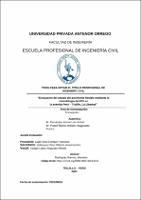| dc.contributor.advisor | Rodrguez Ramos, Mamerto | |
| dc.contributor.author | Fernandez Asmat, Luis Andrei | |
| dc.contributor.author | Pretell Ñamoc, William Regginaldo | |
| dc.creator | Fernandez Asmat, Luis Andrei | |
| dc.date.accessioned | 2021-10-07T15:37:39Z | |
| dc.date.available | 2021-10-07T15:37:39Z | |
| dc.date.issued | 2021 | |
| dc.identifier.uri | https://hdl.handle.net/20.500.12759/8086 | |
| dc.description.abstract | El presente trabajo de investigación tiene como finalidad realizar la evaluación del
estado del pavimento flexible de la Av. Perú mediante el método de PCI (Índice de
Condición de Pavimento). Aproximadamente 1.6 kilómetros de pavimento flexible
han sido analizados de forma minuciosa para identificar, medir y registrar las fallas
existentes en toda la avenida. Luego, se procesaron estos datos calculando el
Índice de Condición del Pavimento que representa el estado de la vía.
Primero, la tesis plantea como problema de investigación el mal estado de la
avenida a causa de factores como el alto flujo vehicular, informalidad de comercios
y la complicada transitabilidad de la vía.
Segundo, en lo que respecta al marco teórico en este se define el concepto de
pavimento flexible, el tipo de evaluación ya sean superficial o estructural y los tipos
de fallas existentes en pavimentos asfálticos.
Tercero, se detalla el procedimiento de la metodología aplicada en la investigación
cuya base principal es el manual del PCI de Vásquez Varela: La selección de
muestras, el cálculo del PCI y sus criterios de análisis. Con esto se especificó el
procedimiento para la inspección de la primera muestra sirviendo como guía para
las demás.
Finalmente, se exponen todas las fichas de registro con el cálculo del Índice de
Condición del Pavimento para todas las muestras seleccionadas.
De esta forma se concluye que la Avenida Perú posee un pavimento flexible en
condiciones MUY MALAS, con un PCI de 17.71.
De igual manera, se recomienda que desde la progresiva 0+000 km hasta la
progresiva 0+300 km se pueda realizar un refuerzo de la superficie de rodadura o
recapeo, reparando previamente cada tipo de falla encontrada en ese tramo.
Asimismo, a partir de la progresiva 0+300 km hasta el final de la vía, se sugiere una
reconstrucción o reconformación de las capas del pavimento ya que este segundo
tramo es el más dañado. Esta división se recomienda con el fin de reducir costos y
no reconstruir completamente la avenida Perú. | es_PE |
| dc.description.abstract | The purpose of this research work is to evaluate the state of the flexible pavement
of Av. Perú using the PCI method (Pavement Condition Index). Approximately 1.6
kilometers of flexible pavement have been meticulously analyzed to identify,
measure and record existing faults throughout the avenue. Then, these data were
processed by calculating the Pavement Condition Index that represents the
condition of the road.
First, the thesis propose the poor condition of the avenue as a research problem
due to factors such as high traffic flow, informality of shops and the complicated
passability of the road.
Second, with regard to the theoretical framework, it defines the concept of flexible
pavement, the type of evaluation, whether superficial or structural, and the types of
existing faults in asphalt pavements.
Third, it details the procedure of the methodology applied in the research whose
main basis is the Vásquez Varela PCI manual: The selection of samples, the
calculation of the PCI and its analysis criteria. With this, the procedure for the
inspection of the first sample was specified, serving as a guide for the others.
Finally, all the registration files are exposed with the calculation of the Pavement
Condition Index for all the selected samples.
In this way, it is concluded that Avenida Perú placed a flexible pavement in VERY
BAD conditions, with a PCI value of 17.71.
In the same way, it is recommended that from the progressive 0 + 000 km to the
progressive 0 + 300 km, a reinforcement of the rolling area or resurfacing can be
carried out, previously repairing each type of fault found in that section. Likewise,
from the progressive 0 + 300 km to the end of the road, a reconstruction or reshaping
of the pavement layers is suggested because this second section is the most
damaged. This division was recommend in order to reduce costs and not to
completely rebuild Peru Avenue. | en_US |
| dc.description.uri | Tesis | es_PE |
| dc.format | application/pdf | es_PE |
| dc.language.iso | spa | es_PE |
| dc.publisher | Universidad Privada Antenor Orrego | es_PE |
| dc.relation.ispartofseries | T_CIV_1984 | |
| dc.rights | info:eu-repo/semantics/closedAccess | es_PE |
| dc.rights.uri | https://creativecommons.org/licenses/by/4.0/ | es_PE |
| dc.source | Universidad Privada Antenor Orrego | es_PE |
| dc.source | Repositorio Institucional - UPAO | es_PE |
| dc.subject | Evaluación del estado del pavimento flexible | es_PE |
| dc.subject | Metodología del PCI | es_PE |
| dc.title | Evaluación del estado del pavimento flexible mediante la metodología del PCI en la avenida Perú – Trujillo, La Libertad | es_PE |
| dc.type | info:eu-repo/semantics/bachelorThesis | es_PE |
| thesis.degree.level | Título Profesional | es_PE |
| thesis.degree.grantor | Universidad Privada Antenor Orrego. Facultad de Ingeniería | es_PE |
| thesis.degree.name | Ingeniero Civil | es_PE |
| thesis.degree.discipline | Ingeniería Civil | es_PE |
| dc.subject.ocde | https://purl.org/pe-repo/ocde/ford#2.01.00 | es_PE |
| renati.advisor.orcid | https://orcid.org/0000-0003-3024-0155 | es_PE |
| renati.author.dni | 48558740 | |
| renati.author.dni | 70668863 | |
| renati.advisor.dni | 18034417 | |
| renati.type | https://purl.org/pe-repo/renati/type#tesis | es_PE |
| renati.level | https://purl.org/pe-repo/renati/level#tituloProfesional | es_PE |
| renati.discipline | 732016 | es_PE |
| renati.juror | Lujan Silva, Enrique Francisco | |
| renati.juror | Velasquez Diaz, Gilberto Anaximandro | |
| renati.juror | Vargas Lopez, Segundo Alfredo | |
| dc.publisher.country | PE | es_PE |


